Apelin and Its Relation with Glucose Metabolism in Adolescents with Type 1 Diabetes Mellitus: Comparative Study
Main Article Content
Abstract
Background: Type 1 diabetes mellitus, also known as insulin-dependent diabetes, characterized by elevated levels of blood glucose (hyperglycemia), which produced by the autoimmune destruction of pancreatic islet β-cells insulin-producing.
Objective: This study aimed to examine the alterations in Apelin, Lipid profiles, fasting blood glucose, HbA1C, calcium, parathyroid hormone and vitamin D in adolescents with type 1 diabetic and healthy adolescents.
Methods: This study was done in the Maternity and Children Teaching Hospital and Al-Ramadi Teaching Hospital in Ramadi city in Iraq, between January 2024 to July 2024. One hundred adolescents were selected: 60 patients with diabetes and 40 healthy as a control group. Biochemical tests for blood samples were performed.
Results: The results showed there was a significantly increase in concentrations of Apelin, lipid profile (except high-density lipoprotein cholesterol), fasting blood glucose, HbA1C and calcium in patients with diabetes than control group. Whereas, there was a significantly reduction in concentration of the high-density lipoprotein cholesterol, parathyroid hormone and vitamin D in patients with diabetes than control group. The results showed a significant positive correlation among glucose concentrations and Apelin concentrations, while there was a significant inverse relationship between blood parathyroid hormone and blood glucose concentrations, and also, there was a significant inverse relationship between vitamin D concentration and HbA1c.
Conclusion: The high serum concentrations of Apelin in diabetic patients supports the function of Apelin in diabetes mellitus development and highlight the utilize of Apelin as a medical sign in diabetes.
Article Details
Issue
Section

This work is licensed under a Creative Commons Attribution 4.0 International License.
